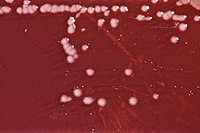
Photo from wikipedia
BackgroundPseudomonas putida is a Gram-negative, non-fermenting bacterium frequently encountered in various environmental niches. P. putida rarely causes disease in humans, though serious infections and outbreaks have been reported from time… Click to show full abstract
BackgroundPseudomonas putida is a Gram-negative, non-fermenting bacterium frequently encountered in various environmental niches. P. putida rarely causes disease in humans, though serious infections and outbreaks have been reported from time to time. Some have suggested that P. putida functions as an exchange platform for antibiotic resistance genes (ARG), and thus represents a serious concern in the spread of ARGs to more pathogenic organisms within a hospital. Though poorly understood, the frequency of ARG exchange between P. putida and the more virulent Pseudomonas aeruginosa and its clinical relevance are particularly important for designing efficient infection control strategies, such as deciding whether high-risk patients colonized with a multidrug resistant but typically low pathogenic P. putida strain should be contact isolated or not.ResultsIn this study, 21,373 screening samples (stool, rectal and throat swab) were examined to determine the presence of P. putida in a high-risk group of haemato-oncology patients during a 28-month period. A total of 89 P. putida group strains were isolated from 85 patients, with 41 of 89 (46.1%) strains harbouring the metallo-beta-lactamase gene blaVIM. These 41 clinical isolates, plus 18 blaVIM positive environmental P. putida isolates, and 17 blaVIM positive P. aeruginosa isolates, were characterized by whole genome sequencing (WGS).We constructed a maximum-likelihood tree to separate the 59 blaVIM positive P. putida group strains into eight distinct phylogenetic clusters. BlaVIM-1 was present in 6 clusters while blaVIM-2 was detected in 4 clusters. Five P. putida group strains contained both, blaVIM-1 and blaVIM-2 genes.In contrast, all P. aeruginosa strains belonged to a single genetic cluster and contained the same ARGs. Apart from blaVIM-2 and sul genes, no other ARGs were shared between P. aeruginosa and P. putida. Furthermore, the blaVIM-2 gene in P. aeruginosa was predicted to be only chromosomally located.ConclusionThese data provide evidence that no exchange of comprehensive ARG harbouring mobile genetic elements had occurred between P. aeruginosa and P. putida group strains during the study period, thus eliminating the need to implement enhanced infection control measures for high-risk patients colonized with a blaVIM positiv P. putida group strains in our clinical setting.
Journal Title: BMC Genomics
Year Published: 2017
Link to full text (if available)
Share on Social Media: Sign Up to like & get
recommendations!